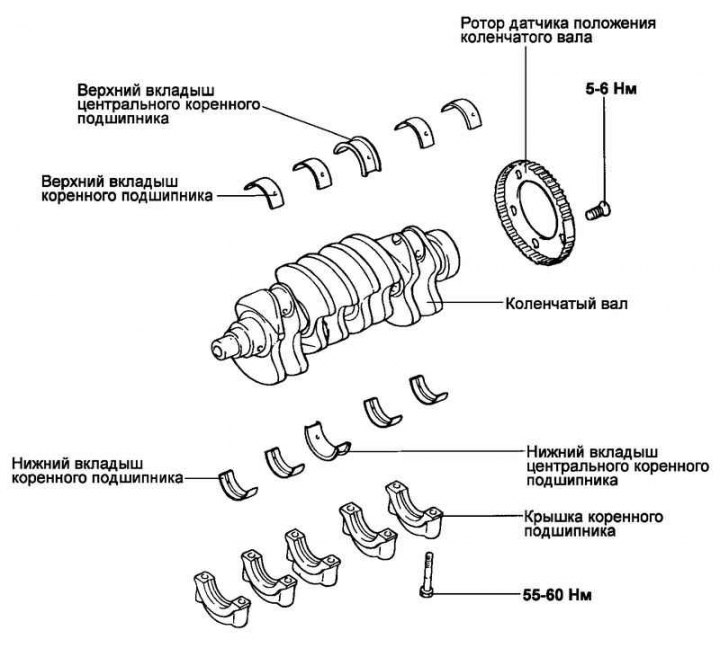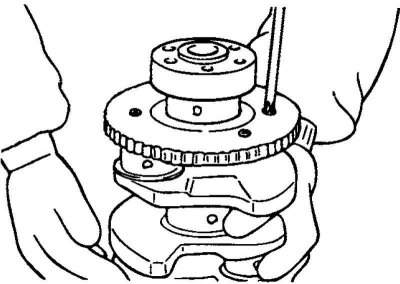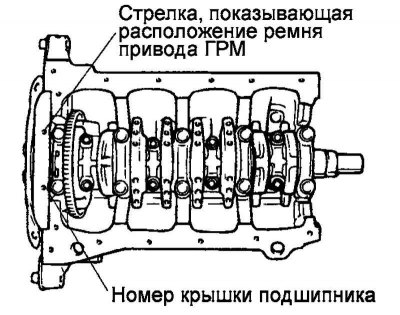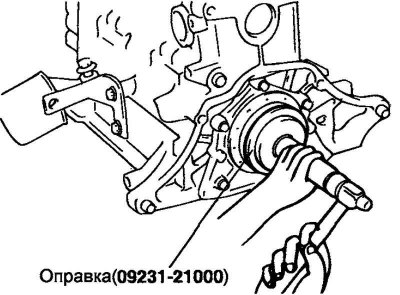
Pic. 2.66. crankshaft components
Disassembly
Remove the timing belt, oil pump housing, flywheel, cylinder head assembly and oil pan. Parts removal procedures are given in the relevant sections.
Remove the cylinder block rear plate and crankshaft rear oil seal.
Remove the connecting rod caps and crankshaft connecting rod bearing shells.
Remove the crankshaft main bearing caps and remove the crankshaft.
Remove the crankshaft position sensor rotor.
Note. For easier installation, position the removed parts (connecting rod caps, connecting rod and main bearing shells) in order of their respective cylinder numbers and installation orientation.
Examination
Check the crankshaft main and connecting rod journals for damage (snags and grips), excessive wear and cracks. Also, check the oil passage holes for clogging. Repair or replace the defective part.
Check the taper and out-of-roundness of the main and connecting rod journals of the crankshaft.
Rated value:
- root neck diameter - 50 mm;
- connecting rod journal diameter - 45 mm;
- taper and out-of-roundness of the main and connecting rod journals - 0.005 mm or less.
Checking the liners of main and connecting rod bearings
Visually inspect the surface condition of each liner (peeling, uneven contact, risks, scuffing, etc.). Replace defective earbuds.
Bearing clearance measurement
Measure the diameter of the main and connecting rod journals of the crankshaft.
Measure the inner diameters of the main bearing holes in the crankshaft bed (in the cylinder block and bearing cap) and holes for connecting rod bearings (in the lower head of the connecting rod and the connecting rod cap).
Measure the thickness of the connecting rod and main bearing shells.
Calculate the clearance in the bearings from the results of the measurements (it is necessary to subtract from the value of the inner diameter of the bore for the bearing the value of the diameter of the shaft neck and the thickness of the bearing shell).
- Connecting rod bearing clearance: 0.018–0.036 mm.
- The clearance in the main bearing: No. 1, 2, 4, 5 - 0.022–0.040 mm, No. 3 - 0.028–0.046 mm.
Checking crankshaft oil seals
Check the front and rear crankshaft oil seals for damage or wear on the sealing lips. In the presence of defects replace an epiploon.
Checking the rotor of the crankshaft position sensor
Remove the crankshaft position sensor rotor.
Check the crankshaft position sensor rotor for damage, cracks and wear. Replace sensor rotor if necessary.

Pic. 2.67. Checking the Gap Between the Sensor Rotor Tooth and the Sensor Tip Using a Depth Gauge
Check the clearance between the sensor rotor tooth and the sensor tip with a depth gauge (pic. 2.67).
The nominal value of the gap between the sensor rotor tooth and the sensor tip: 0.5–1.1 mm.
Note. Measure the distance from the top of the crankshaft position sensor rotor tooth to the sensor mounting surface on the cylinder block.
Measure the length of the crankshaft position sensor tip as the distance between the end face of the sensor tip and the sensor seat.
Calculate the clearance as the difference between the specified values.
Assembly
Install the upper main bearing shells into the crankshaft bed on the cylinder block.
Note. Be careful when installing the main bearing shells removed earlier during disassembly, position them in accordance with the alignment marks made before removal.
Install the crankshaft. Apply engine oil to the crankshaft journals.
Install the lower shells and main bearing caps. Tighten the cap bolts to rated torque in the following sequence: center bearing cap, #2 bearing cap, #4 bearing cap, front bearing cap, and rear bearing cap.
Tighten the bolts gradually in two or three steps, then tighten to the specified torque.

Pic. 2.68. Installing main bearing caps
When installing the covers, they must be positioned so that the arrows of the covers are directed towards the crankshaft pulley and the numbers of the covers correspond to the numbers of the cylinders (pic. 2.68).
The moment of an inhaling of bolts of fastening of covers of radical bearings: 55–60 Nm, bolts of fastening of covers of a rod: 32–35 Nm.
Check again that the crankshaft rotates smoothly and the crankshaft end play is (clearance between the thrust flange of the central main bearing and the corresponding web of the crankshaft) corresponds to the nominal value.
Rated value: axial clearance of the crankshaft - 0.050–0.175 mm.

Pic. 2.69. Installation of a back epiploon of a cranked shaft
With a special tool (mandrel for installing the rear oil seal of the crankshaft 09231-2100) install the crankshaft rear oil seal into the oil seal housing, as shown in Figure 2.69. Be careful to correctly position the mandrel so as not to damage or deform the oil seal during installation.
Establish a back plate of the block of cylinders and tighten bolts of its fastening.
Install the connecting rod caps.
Install the flywheel, oil pump housing, oil pan and timing belt. Parts installation procedures are given in the relevant sections.
